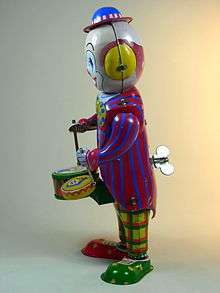Wind-up toy
A wind-up toy is an automaton toy powered by a clockwork motor.[1]

History
Automata built for the sake of art, amusement, and simulation have been described since antiquity, in cases such as Heron of Alexandria designing clockwork birds during the Hellenistic Period.[2] Leonardo da Vinci is frequently credited with constructing a mechanical lion, which he presented to King Francois I in Lyon in 1515. Although no record of the device's original designs remain, a recreation of this piece is housed at the Château du Clos Lucé.[3]
Some misinformation exists with regards to Regiomontanus's contribution, and his supposed construction of a flight-capable mechanical eagle and fly, which are frequently credited as the first wind-up toys. This story of an eagle which flew from Nuremberg to greet Friedrich III, alongside that of a fly which could circulate the room before returning to its inventor's hand, was spread by Petrus Ramus after a visit to Nuremberg in 1571, and is apparently false.[4] Furthermore, various internet sites instead credit these inventions to a Karel Grod[5], but little evidence suggests he exists.
René Descartes may have attempted to build some automata. According to legend, a life-sized wind-up human girl was discovered in his luggage aboard a ship in which he was traveling to Sweden, and was thrown overboard by order of the ship's Captain.[1]
After the larger, elaborate wind-up machine art declined in interest, wind-up toys were created cheaply in large numbers by the 1800s. Wind-up machines became known as wind-up toys, and were designed in different forms to move around.[1] European toy makers created and mass-produced the first windup tin toys during the late 1880s. Over the next 60 to 70 years, more manufacturers created more intricate designs. The trend stopped with the introduction of the small and inexpensive Alkaline battery in the 1960s, which allowed motors to run without a wind up mechanism. Over the next 20 years, wind up toys lost popularity.
Plastic Wind-ups started in 1977 when the Japanese company Tomy made a walking Robot (Rascal Robot). Tomy's ability to build small precise plastic gears and parts allowed them to reduce the size of the gearbox (housing the spring drive).
See also
References
- Brett, Gerard (July 1954). "The Automata in the Byzantine "Throne of Solomon"". Speculum. The University of Chicago Press. 29 (3): 477–487. doi:10.2307/2846790. JSTOR 2846790.
- Shirbon, Estelle (August 14, 2009). "Da Vinci's lion prowls again after 500 years". Reuters. Retrieved April 12, 2019.
- Zinner, Ernst (1990). Regiomontanus: His Life and Work. Translated by Brown, Ezra. New York, NY: Elsevier Science Publishing Company Inc. p. 135. ISBN 978-0444887924.
- Moyer, Richard H.; Everett, Susan A. (1 August 2016). More Everyday Engineering: Putting the E in STEM Teaching and Learning. NSTA Press. ISBN 9781681402796. Retrieved 25 October 2017 – via Google Books.